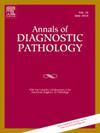Histopathological and prognostic variability of ampullary tumors: A comprehensive study on tumor location, histological subtypes, and survival outcomes
IF 1.4
4区 医学
Q3 PATHOLOGY
引用次数: 0
Abstract
Ampullary tumors present diagnostic challenges due to the complex anatomical and histological structure of the ampullary region. They can be classified into four types based on location: Periampullary-duodenal, intra-ampullary, ampullary-ductal, and ampullary-NOS (not otherwise specified). Periampullary-duodenal tumors are exophytic, ulcerovegetative, and often intestinal-type adenocarcinomas with frequent lymph node metastasis. Intra-ampullary tumors are polypoid and confined to the ampullary canal. Ampullary-ductal tumors exhibit sclerotic thickening in the bile or pancreatic duct and are typically pancreatobiliary-type adenocarcinomas. Ampullary-NOS includes tumors that do not fit other classifications. This study aimed to classify ampullary tumors by their anatomical localization, compare histopathological features, and assess the prognostic outcomes for each group. A total of 111 ampullary tumors were selected from 229 pancreaticoduodenectomy specimens over 10 years at our hospital. Clinical, imaging, and macroscopic findings were re-evaluated microscopically. Tumors were classified into four anatomical groups, and their histopathological characteristics and prognosis were analyzed. The cohort had a mean age of 62 ± 10.49 years, with 69 (62.2 %) males and 42 (37.8 %) females. The median survival was 28.23 months. Tumor distribution was as follows: 14.4 % intra-ampullary, 25.2 % ampullary-ductal, 10.8 % periampullary-duodenal, and 49.5 % not otherwise specified (NOS). Pancreatobiliary-type adenocarcinoma (p = 0.003), perineural invasion (p < 0.0001), and lymphovascular invasion (p = 0.002) were significantly more frequent in the ampullary-ductal and NOS groups, which were associated with poorer overall survival (p = 0.011). In addition, lymphovascular invasion and surgical margin positivity were identified as independent prognostic markers. Classifying ampullary tumors based on anatomical location is crucial due to significant histopathological and prognostic differences between the groups.
壶腹肿瘤的组织病理学和预后变异性:一项关于肿瘤位置、组织学亚型和生存结果的综合研究
由于壶腹区复杂的解剖和组织学结构,壶腹肿瘤的诊断面临挑战。它们可根据位置分为四种类型:壶腹周围-十二指肠、壶腹内、壶腹-导管和壶腹- nos(未另行说明)。壶腹-十二指肠周围肿瘤为外生性、植性溃疡,常为肠型腺癌,常伴有淋巴结转移。壶腹内肿瘤呈息肉状,局限于壶腹管。壶腹导管肿瘤表现为胆管或胰管硬化增厚,是典型的胰胆管型腺癌。壶腹- nos包括不适合其他分类的肿瘤。本研究旨在通过解剖定位对壶腹肿瘤进行分类,比较组织病理学特征,并评估每组的预后结果。在我院10年来229例胰十二指肠切除术标本中,共筛选出111例壶腹部肿瘤。在显微镜下重新评估临床、影像学和宏观表现。将肿瘤分为4个解剖类群,分析其组织病理学特征及预后。该队列平均年龄为62±10.49岁,男性69例(62.2%),女性42例(37.8%)。中位生存期为28.23个月。肿瘤分布如下:壶腹内14.4%,壶腹-导管25.2%,壶腹-十二指肠周围10.8%,其他未明确(NOS) 49.5%。胰胆管型腺癌(p = 0.003),神经周围浸润(p <;0.0001),壶腹-导管组和NOS组的淋巴血管侵犯(p = 0.002)明显更频繁,这与较差的总生存率相关(p = 0.011)。此外,淋巴血管浸润和手术切缘阳性被确定为独立的预后指标。基于解剖位置对壶腹肿瘤进行分类是至关重要的,因为两组之间的组织病理学和预后存在显著差异。
本文章由计算机程序翻译,如有差异,请以英文原文为准。
求助全文
约1分钟内获得全文
求助全文
来源期刊
CiteScore
3.90
自引率
5.00%
发文量
149
审稿时长
26 days
期刊介绍:
A peer-reviewed journal devoted to the publication of articles dealing with traditional morphologic studies using standard diagnostic techniques and stressing clinicopathological correlations and scientific observation of relevance to the daily practice of pathology. Special features include pathologic-radiologic correlations and pathologic-cytologic correlations.

 求助内容:
求助内容: 应助结果提醒方式:
应助结果提醒方式:


